A Numerical Study of Effects of Radiation on Deep Convective Warm Based Cumulus Cloud Development with a 3-D Radiative Transfer Model
Abstract
:1. Introduction
2. The Model Introduction
2.1. Microphysics
2.2. Radiation Scheme
- (1)
- The source function is transformed to discrete ordinates from spherical harmonics at each grid point.
- (2)
- The source function is integrated using the radiative transfer equation in discrete ordinates to obtain the radiation field at each grid point.
- (3)
- The radiation field is transformed to spherical ordinates.
- (4)
- The source function is computed from the radiation field in spherical harmonics. To balance the accuracy and efficiency of the calculation, the radiance is calculated in a certain order in SHDOM, and the specific content and algorithm will be introduced.
3. Experimental Design
4. Simulation Results
4.1. The Radiation Simulation Results by Vertical Incidence
4.1.1. The Effects of Vertical Incidence on Shortwave Radiation
4.1.2. Longwave Radiation Simulation Results
4.2. The Radiation Simulation Results by the True Zenith Angle
The Effects of the True Zenith Angle Incidence on Shortwave Radiation
5. Discussion
6. Summary and Conclusions
- (1)
- In the 1D radiation model, grid points are independent of each other in the calculation, the absorption and scattering only occur in the vertical direction, and neither the optical variability nor the horizontal cloud particles are taken into account. In this case, the interactions between two cloudy regions or between clouds and ambient air are not considered in the simulation. As a result, there is a clear distinction between the cloudy grid point and the cloudless grid point. In the vertical direction, the radiation cannot pass through the cloudy area due to the shadow of the cloud, which results in spurious high-value or low-value regions that exist at the model top. This deviation can accumulate over time and affect cloud microphysics and dynamic processes.
- (2)
- In the 3D radiation model, the solver computes the radiation transmission, including upward and downward streams, and additionally for sideward streams, the scattering intensity of cloud particles depends on the phase function of the direction, such that photons scattered in multiple directions by cloud particles can travel through the air until encountering new cloud particles. The scattered radiation structure is reasonable, and the distribution of scattered radiation corresponds to the cloud field. In addition, the horizontal transmission and multiple scattering can also cause radiation disturbance in noncloudy regions. As a result, the radiation presents a clear structure around the cloud field, and the cloud area affects the cloud-free area through horizontal transmission, which makes the cloud and cloud-free regions linked to each other and excessive, allowing for the interaction between two clouds.
- (3)
- In the true zenith angle case, the most obvious difference between 1D and 3D radiation transfer is the distribution of radiation to the cloud top and the displacement of the sun’s shadow on the surface ground. In 1D radiation transmission, the distribution of radiant energy is completely symmetric regardless of the zenith angle, and the shadow of the cloud is directly underneath the cloud. In 3D radiation, the solar flux facing the incident radiation direction is greater than that deviating from the incident direction at the cloud top, and the cloud shadow is based on the position of the sun.
- (4)
- The influence of radiation feedback on the cloud is eventually reflected in the atmospheric heating rate and ultimately affects the development of the clouds. For shortwave radiation, in the 1D radiation case, the cloud fields affect the atmospheric heating rate in the vertical direction but not in the horizontal direction. The heating rate above the cloud top is higher than that of the 3D radiation scheme, while the heating rate on the side of the cloud is lower than that of the 3D radiation scheme. In the 3D radiation case, the solar radiation heating is likely to increase perpendicular to the solar incidence direction in the cloud field, and the heating rate of the ambient air produces a disturbance due to horizontal transmission beside the cloud fields. The horizontal displacement of the cloud shadow also affects the surface heat flux through the land surface model. This complex relationship between the asymmetric distribution structure of the atmospheric heating rate and radiation propagation may promote or hinder cloud formation and development. For longwave radiation, the cooling effect at the cloud top and the heating effect at the cloud bottom are both more intense in the 3D radiation model.
Author Contributions
Funding
Conflicts of Interest
References
- Chin, H.N.S. The impact of the ice phase and radiation on a midlatitude squall line system. J. Atmos. Sci. 1994, 51, 3320–3343. [Google Scholar] [CrossRef] [Green Version]
- Dudhia, J. A history of mesoscale model development. Asia Pac. J. Atmos. Sci. 2014, 50, 121–131. [Google Scholar] [CrossRef]
- Fu, Q.; Krueger, S.K.; Liou, K.N. Interactions of radiation and convection in simulated tropical cloud clusters. J. Atmos. Sci. 1995, 52, 1310–1328. [Google Scholar] [CrossRef] [Green Version]
- Gautier, C. A Three-Dimensional radiative transfer model to investigate the solar radiation within a cloudy atmosphere. Part II: Spectral effects. J. Atmos. Sci. 1998, 55, 2162–2179. [Google Scholar]
- Gross, M.; Wan, H.; Rasch, P.J.; Caldwell, P.M.; Williamson, D.L.; Klocke, D.; Jablonowski, C.; Thatcher, D.R.; Wood, N.; Cullen, M.; et al. Physics–dynamics coupling in weather, climate, and Earth system models: Challenges and recent progress. Mon. Weather Rev. 2018, 146, 3505–3544. [Google Scholar] [CrossRef]
- Johnson, D.E.; Tao, W.-K.; Simpson, J. A study of the response of deep tropical clouds to large-scale thermodynamic forcings. Part II: Sensitivities to microphysics, radiation, and surface fluxes. J. Atmos. Sci. 2007, 64, 869–886. [Google Scholar] [CrossRef]
- Lee, M.I.; Kang, I.S.; Kim, J.K.; Mapes, B.E. Influence of cloud-radiation interaction on simulating tropical intraseasonal oscillation with an atmospheric general circulation model. J. Geophys. Res. Atmos. 2001, 106, 14219–14233. [Google Scholar] [CrossRef]
- Li, X.; Sui, C.H.; Lau, K.M.; Chou, M.D. Large-scale forcing and cloud–radiation interaction in the tropical deep convective regime. J. Atmos. Sci. 1999, 56, 3028–3042. [Google Scholar] [CrossRef]
- Liang, X.Z.; Wu, X. Evaluation of a GCM subgrid cloud-radiation interaction parameterization using cloud-resolving model simulations. Geophys. Res. Lett. 2005, 32. [Google Scholar] [CrossRef] [Green Version]
- Microphysics, Radiation and Surface Processes in the Goddard Cumulus Ensemble (GCE) Model. 2001. Available online: https://ui.adsabs.harvard.edu/abs/2003MAP....82...97T/abstract (accessed on 18 October 2020).
- Tao, W.K.; Simpson, J.; Sui, C.H.; Ferrier, B.; Lang, S.; Scala, J.; Chou, M.D.; Pickering, K. Heating, moisture, and water budgets of tropical and midlatitude squall lines: Comparisons and sensitivity to longwave radiation. J. Atmos. Sci. 1993, 50, 673–690. [Google Scholar] [CrossRef] [Green Version]
- Wiscombe, W.J.; Ramanathan, V. The role of radiation and other renascent subfields in atmospheric science. Bull. Am. Meteorol. Soc. 1985, 66, 1278–1287. [Google Scholar] [CrossRef] [Green Version]
- Zhang, F.; Yan, J.R.; Li, J.; Wu, K.; Iwabuchi, H.; Ning-Shi, Y. A new radiative transfer method for solar radiation in a vertically internally inhomogeneous medium. J. Atmos. Sci. 2017, 75, 41–55. [Google Scholar] [CrossRef]
- Chen, T.; Zhang, Y.; Rossow, W.B. Sensitivity of atmospheric radiative heating rate profiles to variations of cloud layer overlap. J. Clim. 2000, 13, 2941–2959. [Google Scholar] [CrossRef]
- Gu, Y.; Farrara, J.; Liou, K.N.; Mechoso, C.R. Parameterization of cloud–radiation processes in the UCLA general circulation model. J. Clim. 2003, 16, 3357–3370. [Google Scholar] [CrossRef]
- Klinger, C.; Mayer, B.C.; Jakub, F.; Zinner, T. Effects of 1D and 3D Thermal Radiation on Cloud Dynamics and Microphysics. AGU Fall Meeting Abstracts. 2016. Available online: https://ui.adsabs.harvard.edu/abs/2016AGUFM.A52C..07K/abstract (accessed on 14 October 2020).
- Liou, K.N.; Davies, R. Radiation and cloud processes in the atmosphere. Theory, observation, and modeling. Phys. Today 1993, 46, 66–67. [Google Scholar] [CrossRef]
- Menon, S.; Rotstayn, L. The radiative influence of aerosol effects on liquid-phase cumulus and stratiform clouds based on sensitivity studies with two climate models. Clim. Dyn. 2006, 27, 345–356. [Google Scholar] [CrossRef] [Green Version]
- Smith, L.D.; Vonder Haar, T.H. Clouds-radiation interactions in a general circulation model: Impact upon the planetary radiation balance. J. Geophys. Res. Atmos. 1991, 96, 893–914. [Google Scholar] [CrossRef]
- Xu, K.-M.; Randall, D.A. Impact of interactive radiative transfer on the macroscopic behavior of cumulus ensembles. Part II: Mechanisms for cloud-radiation interactions. J. Atmos. Sci. 1995, 52, 800–817. [Google Scholar] [CrossRef] [Green Version]
- Gu, Y.; Farrara, J.; Liou, K.-N.; Mechoso, C.R. Interactions of radiation, microphysics, and turbulence in the evolution of cirrus clouds. J. Atmos. Sci. 2000, 57, 2463–2479. [Google Scholar] [CrossRef]
- Li, J.-L.F.; Lee, W.-L.; Waliser, D.E.; Neelin, J.D.; Stachnik, J.P.; Lee, T. Cloud-precipitation-radiation-dynamics interaction in global climate models: A snow and radiation interaction sensitivity experiment. J. Geophys. Res. Atmos. 2014, 119, 3809–3824. [Google Scholar] [CrossRef] [Green Version]
- Klinger, C.; Feingold, G.; Yamaguchi, T. Cloud droplet growth in shallow cumulus clouds considering 1-D and 3-D thermal radiative effects. Atmos. Chem. Phys. 2019, 19, 6295–6313. [Google Scholar] [CrossRef] [Green Version]
- Mateos, D.; Pace, G.; Meloni, D.; Bilbao, J.; Di, S.A.; De, M.A. Observed influence of liquid cloud microphysical properties on ultraviolet surface radiation. J. Geophys. Res. Atmos. 2014, 119, 2429–2440. [Google Scholar] [CrossRef]
- Milbrandt, J.A.; Yau, M.K. A multimoment bulk microphysics parameterization. Part I: Analysis of the role of the spectral shape parameter. J. Atmos. Sci. 2005, 62, 3051–3064. [Google Scholar] [CrossRef] [Green Version]
- Boucher, O.; Le Treut, H.; Baker, M.B. Precipitation and radiation modelling in a GCM: Introduction of cloud microphysical processes. J. Geophys. Res. Atmos. 1995, 100, 16395–16414. [Google Scholar] [CrossRef]
- Gu, Y.; Liou, K.N.; Lee, W.L.; Leung, L.R. Simulating 3-D radiative transfer effects over the Sierra Nevada mountains using WRF. Atmos. Chem. Phys. 2012, 12, 9965. [Google Scholar] [CrossRef] [Green Version]
- Jayaraman, A. Aerosol radiation cloud interactions over the tropical Indian Ocean prior to the onset of the summer monsoon. Curr. Sci. 2001, 81, 1437–1445. [Google Scholar]
- Lohou, F.; Patton, E.G. Surface energy balance and buoyancy response to shallow cumulus shading. J. Atmos. Sci. 2014, 71, 665–682. [Google Scholar] [CrossRef] [Green Version]
- Fritz, S. Solar radiant energy and its modification by the earth and its atmosphere. In Compendium of Meteorology; American Meteorological Society: Boston, MA, USA, 1951; pp. 13–33. [Google Scholar]
- Jakub, F.; Mayer, B. The role of 1-D and 3-D radiative heating in the organization of shallow cumulus convection and the formation of cloud streets. Atmos. Chem. Phys. 2017, 17, 13317–13327. [Google Scholar] [CrossRef] [Green Version]
- Medvigy, D.; Beaulieu, C. Trends in daily solar radiation and precipitation coefficients of variation since 1984. J. Clim. 2012, 25, 1330–1339. [Google Scholar] [CrossRef]
- Benner, T.C.; Curry, J.A. Characteristics of small tropical cumulus clouds and their impact on the environment. J. Geophys. Res. Atmos. 1998, 103, 28753–28767. [Google Scholar] [CrossRef]
- Houze, R.A., Jr. Types of clouds in Earth’s atmosphere. In International Geophysics; Academic Press: Cambridge, MA, USA, 2014; Volume 104, pp. 3–23. [Google Scholar]
- Shukla, J.; Sud, Y. Effect of cloud-radiation feedback on the climate of a general circulation model. J. Atmos. Sci. 1981, 38, 2337–2353. [Google Scholar] [CrossRef] [Green Version]
- Nakajima, T.; Tanaka, M. Matrix formulations for the transfer of solar radiation in a plane-parallel scattering atmosphere. J. Quant. Spectrosc. Radiat. Transf. 1986, 35. [Google Scholar] [CrossRef]
- Evans, K.F.; Stephens, G.L. A new polarized atmospheric radiative transfer model. J. Quant. Spectrosc. Radiat. Transf. 1991, 46, 413–423. [Google Scholar] [CrossRef]
- Xiang, X.; Smith, E.A.; Justus, C.G. A rapid radiative transfer model for reflection of solar radiation. J. Atmos. Sci. 1994, 51, 1978–1988. [Google Scholar] [CrossRef] [Green Version]
- Lee, W.L.; Gu, Y.; Liou, K.N.; Leung, L.R. A global model simulation for 3-D radiative transfer impact on surface hydrology over the Sierra Nevada and Rocky Mountains. Atmos. Chem. Phys. 2015, 15, 5405–5413. [Google Scholar] [CrossRef] [Green Version]
- Kablick, G.P., III; Ellingson, R.G.; Takara, E.E.; Gu, J. Longwave 3D Benchmarks for Inhomogeneous Clouds and Comparisons with Approximate Methods. J. Clim. 2011, 24, 2192–2205. [Google Scholar] [CrossRef] [Green Version]
- Hogan, R.J.; Fielding, M.D.; Barker, H.W.; Villefranque, N.; Schäfer, S.A.K. Entrapment: An important mechanism to explain the shortwave 3D radiative effect of clouds. J. Atmos. Sci. 2019, 2019, 48–66. [Google Scholar] [CrossRef]
- Barker, H.W.; Kato, S.; Wehr, T. Computation of solar radiative fluxes by 1D and 3D methods using cloudy atmospheres inferred from a-train satellite data. Surv. Geophys. 2012, 33, 657–676. [Google Scholar] [CrossRef] [Green Version]
- Fauchez, T.; Davis, A.B.; Cornet, C.; Szczap, F.; Platnick, S.; Dubuisson, P.; Thieleux, F. A fast hybrid (3-D/1-D) model for thermal radiative transfer in cirrus via successive orders of scattering. J. Geophys. Res. Atmos. 2017, 122. [Google Scholar] [CrossRef]
- Evans, K.F. The spherical harmonics discrete ordinate method for three-dimensional atmospheric radiative transfer. J. Atmos. Sci. 1998, 55, 429–446. [Google Scholar] [CrossRef]
- Kattawar, G.W.; Plass, G.N. Radiance and polarization of multiple scattered light from haze and clouds. Appl. Opt. 1968, 7, 1519–1527. [Google Scholar] [CrossRef] [Green Version]
- Liu, Q.; Simmer, C.; Ruprecht, E. Three-dimensional radiative transfer effects of clouds in the microwave spectral range. J. Geophys. Res. Atmos. 1996, 101, 4289–4298. [Google Scholar] [CrossRef] [Green Version]
- Skamarock, W.C.; Klemp, J.B. A time-split nonhydrostatic atmospheric model for weather research and forecasting applications. J. Comput. Phys. 2008, 227, 3465–3485. [Google Scholar] [CrossRef]
- Doicu, A.; Efremenko, D.; Trautmann, T. A multi-dimensional vector spherical harmonics discrete ordinate method for atmospheric radiative transfer. J. Quant. Spectrosc. Radiat. Transf. 2013, 118, 121–131. [Google Scholar] [CrossRef]
- Doicu, A.; Efremenko, D.; Trautmann, T. An analysis of the short-characteristic method for the spherical harmonic discrete ordinate method (SHDOM). J. Quant. Spectrosc. Radiat. Transf. 2013, 119, 114–127. [Google Scholar] [CrossRef]
- Lyapustin, A. Radiative transfer code SHARM-3D for radiance simulations over a non-Lambertian nonhomogeneous surface: Intercomparison study. Appl. Opt. 2002, 41, 5607–5615. [Google Scholar] [CrossRef] [Green Version]
- Pincus, R.; Evans, K.F. Computational cost and accuracy in calculating three-dimensional radiative transfer: Results for new implementations of Monte Carlo and SHDOM. J. Atmos. Sci. 2009, 66, 3131–3146. [Google Scholar] [CrossRef] [Green Version]
- Done, J.; Davis, C.A.; Weisman, M. The next generation of NWP: Explicit forecasts of convection using the Weather Research and Forecasting (WRF) model. Atmos. Sci. Lett. 2004, 5, 110–117. [Google Scholar] [CrossRef]
- Hu, X.M.; Nielsen-Gammon, J.W.; Zhang, F. Evaluation of three planetary boundary layer schemes in the WRF model. J. Appl. Meteorol. Climatol. 2010, 49, 1831–1844. [Google Scholar] [CrossRef] [Green Version]
- Jiménez, P.A.; Dudhia, J.; González-Rouco, J.F.; Navarro, J.; Montávez, J.P.; García-Bustamante, E. A revised scheme for the WRF surface layer formulation. Mon. Weather Rev. 2012, 140, 898–918. [Google Scholar] [CrossRef] [Green Version]
- Knievel, J.C.; Bryan, G.H.; Hacker, J.P. Explicit numerical diffusion in the WRF model. Mon. Weather Rev. 2007, 135, 3808–3824. [Google Scholar] [CrossRef]
- Li, J.G. Upstream nonoscillatory advection schemes. Mon. Weather Rev. 2008, 136, 4709–4729. [Google Scholar] [CrossRef]
- Mirocha, J.D.; Lundquist, J.K.; Kosović, B. Implementation of a nonlinear subfilter turbulence stress model for large-eddy simulation in the Advanced Research WRF model. Mon. Weather Rev. 2010, 138, 4212–4228. [Google Scholar] [CrossRef]
- Stevens, B.; Moeng, C.H.; Ackerman, A.S.; Bretherton, C.S.; Andreas, C.; Roode, S.D.; Edwards, J.; Golaz, J.C.; Jiang, H.; Khairoutdinov, M.; et al. Evaluation of large-eddy simulations via observations of nocturnal marine stratocumulus. Mon. Weather Rev. 2005, 133, 1443–1462. [Google Scholar] [CrossRef] [Green Version]
- Khain, A.; Pokrovsky, A.; Pinsky, M.; Seifert, A.; Phillips, V.T.J. Simulation of effects of atmospheric aerosols on deep turbulent convective clouds using a spectral microphysics mixed-phase cumulus cloud model. part I: Model description and possible applications. J. Atmos. Sci. 2004, 61, 2963–2982. [Google Scholar] [CrossRef] [Green Version]
- Khain, A.; Pokrovsky, A. Simulation of effects of atmospheric aerosols on deep turbulent convective clouds using a spectral microphysics mixed-phase cumulus cloud model. part II: Sensitivity study. J. Atmos. Sci. 2004, 61, 2983–3001. [Google Scholar] [CrossRef]
- Tzitzvashvili, S.T.; Feingold, G.; Levin, Z. The evolution of raindrop spectra. part II: Collisional collection/breakup and evaporation in a rainshaft. J. Atmos. Sci. 1989, 46, 3312–3328. [Google Scholar] [CrossRef] [Green Version]
- Khain, A.P.; Leung, L.R.; Lynn, B.; Ghan, S. Effects of aerosols on the dynamics and microphysics of squall lines simulated by spectral bin and bulk parameterization schemes. J. Geophys. Res. Atmos. 2009, 114. [Google Scholar] [CrossRef] [Green Version]
- Khain, A.; Lynn, B.; Dudhia, J. Aerosol effects on intensity of landfalling hurricanes as seen from simulations with the WRF model with spectral bin microphysics. J. Atmos. Sci. 2009, 67, 365–384. [Google Scholar] [CrossRef] [Green Version]
- Khain, A.; Rosenfeld, D.; Pokrovsky, A. Aerosol impact on the dynamics and microphysics of deep convective clouds. Q. J. R. Meteorol. Soc. 2010, 131, 2639–2663. [Google Scholar] [CrossRef] [Green Version]
- Ramanathan, V.; Cess, R.D.; Harrison, E.F.; Minnis, P.; Barkstrom, B.R.; Ahmad, E.; Hartmann, D. Cloud-radiative forcing and climate: Results from the Earth Radiation Budget Experiment. Science 1989, 243, 57–63. [Google Scholar] [CrossRef] [Green Version]
- Ackerman, S.A.; Cox, S.K. Aircraft observations of the shortwave fractional absorptance of non-homogeneous clouds. J. Appl. Meteorol. 1981, 20, 1510–1515. [Google Scholar] [CrossRef] [Green Version]
- Harrison, R.M.; Sturges, W.T.; Kitto, A.M.N.; Li, Y. Kinetics of evaporation of ammonium chloride and ammonium nitrate aerosols. Atmos. Environ. Part. A. Gen. Top. 1990, 24, 1883–1888. [Google Scholar] [CrossRef]
- Klinger, C.; Mayer, B.; Jakub, F.; Zinner, T.; Park, S.-B.; Gentine, P. Effects of 3-D thermal radiation on the development of a shallow cumulus cloud field. Atmos. Chem. Phys. 2017, 17, 5477. [Google Scholar] [CrossRef] [Green Version]
- Cahalan, R.F.; Ridgway, W.; Wiscombe, W.J.; Bell, T.L.; Snider, J.B. The albedo of fractal stratocumulus clouds. J. Atmos. Sci. 1994, 51, 2434–2455. [Google Scholar] [CrossRef]
- Mlawer, E.J.; Taubman, S.J.; Brown, P.D.; Iacono, M.J.; Clough, S.A. Radiative transfer for inhomogeneous atmospheres: RRTM, a validated correlated-k model for the longwave. J. Geophys. Res. Atmos. 1997, 102, 16663–16682. [Google Scholar] [CrossRef] [Green Version]
- Igel, A.L.; van den Heever, S.C. The importance of the shape of cloud droplet size distributions in shallow cumulus clouds. part II: Bulk microphysics simulations. J. Atmos. Sci. 2017, 74, 259–273. [Google Scholar] [CrossRef] [Green Version]
- Kikuchi, N.; Nakajima, T.; Kumagai, H.; Kuroiwa, H.; Kamei, A.; Nakamura, R.; Nakajima, T. Cloud optical thickness and effective particle radius derived from transmitted solar radiation measurements: Comparison with cloud radar observations. J. Geophys. Res. Atmos. 2006, 111. [Google Scholar] [CrossRef] [Green Version]
- Nakajima, T.; King, M.D.; Spinhirne, J.D.; Radke, L.F. Determination of the optical thickness and effective particle radius of clouds from reflected solar radiation measurements. Part, I.: Theory. Nature 1991, 517, 41.e1–41.e21. [Google Scholar] [CrossRef] [Green Version]
- Yue, W.; Daren, L.; Juan, H. Determination of the optical thickness and effective particle radius of clouds from transmitted solar radiation measurements. Prog. Nat. Sci. 2007, 017, 1199–1207. [Google Scholar]
- Yau, M.K. A two-cylinder model of cumulus cells and its application in computing cumulus transports. J. Atmos. Sci. 1980, 37, 2470–2485. [Google Scholar] [CrossRef]
- Liou, K.N. An Introduction to Atmospheric Radiation; Academic Press: Cambridge, MA, USA, 1980. [Google Scholar]
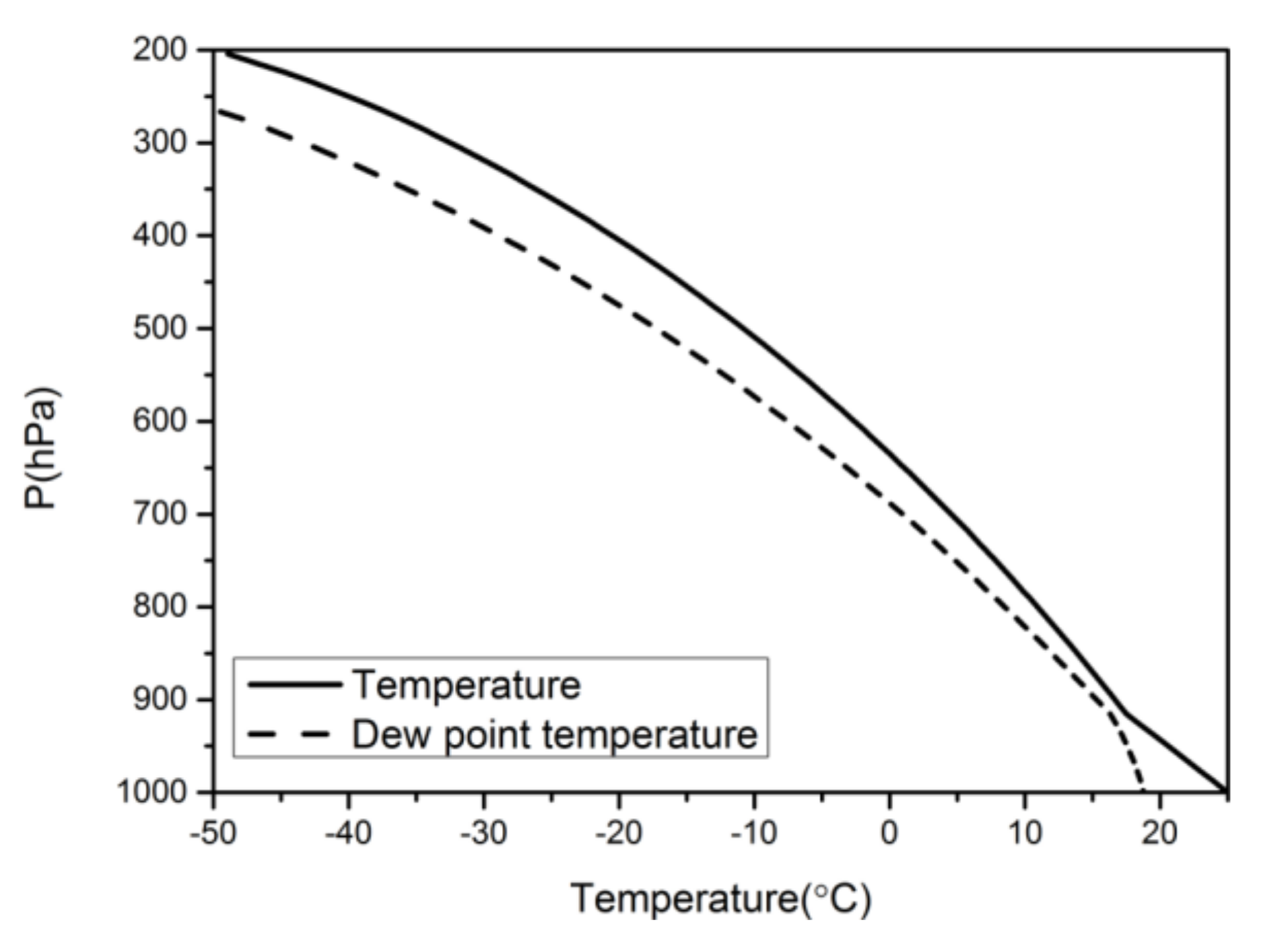
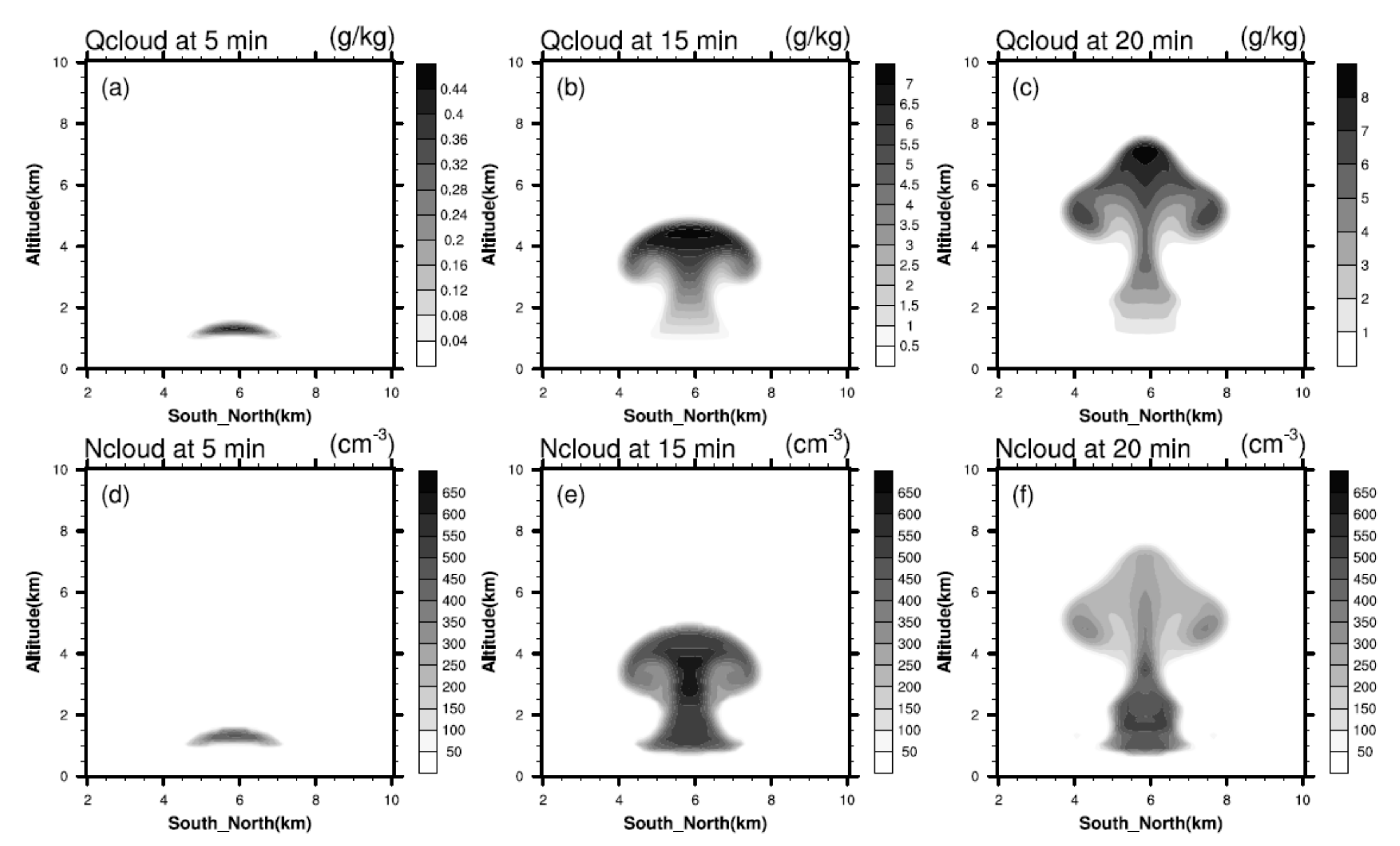
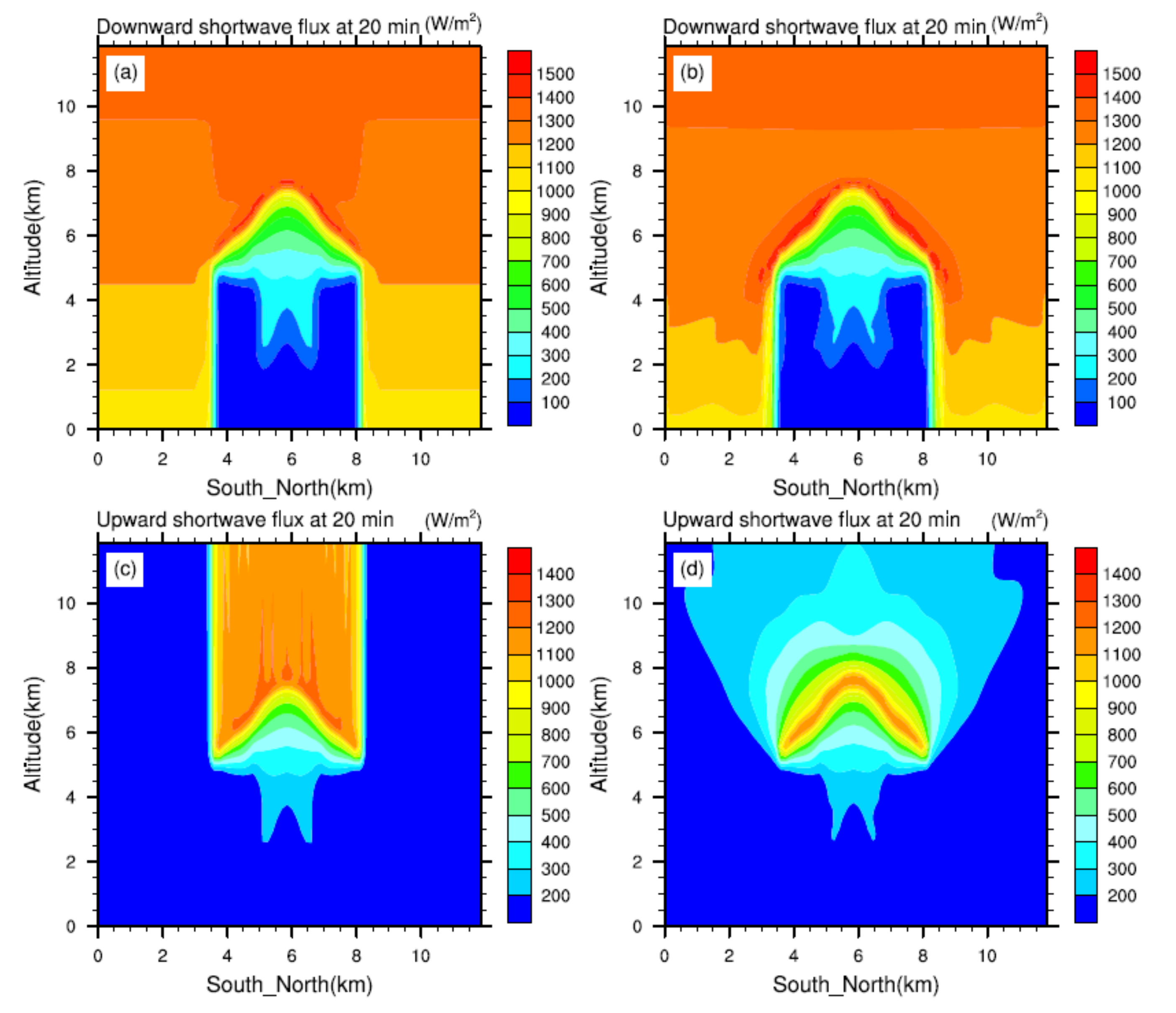
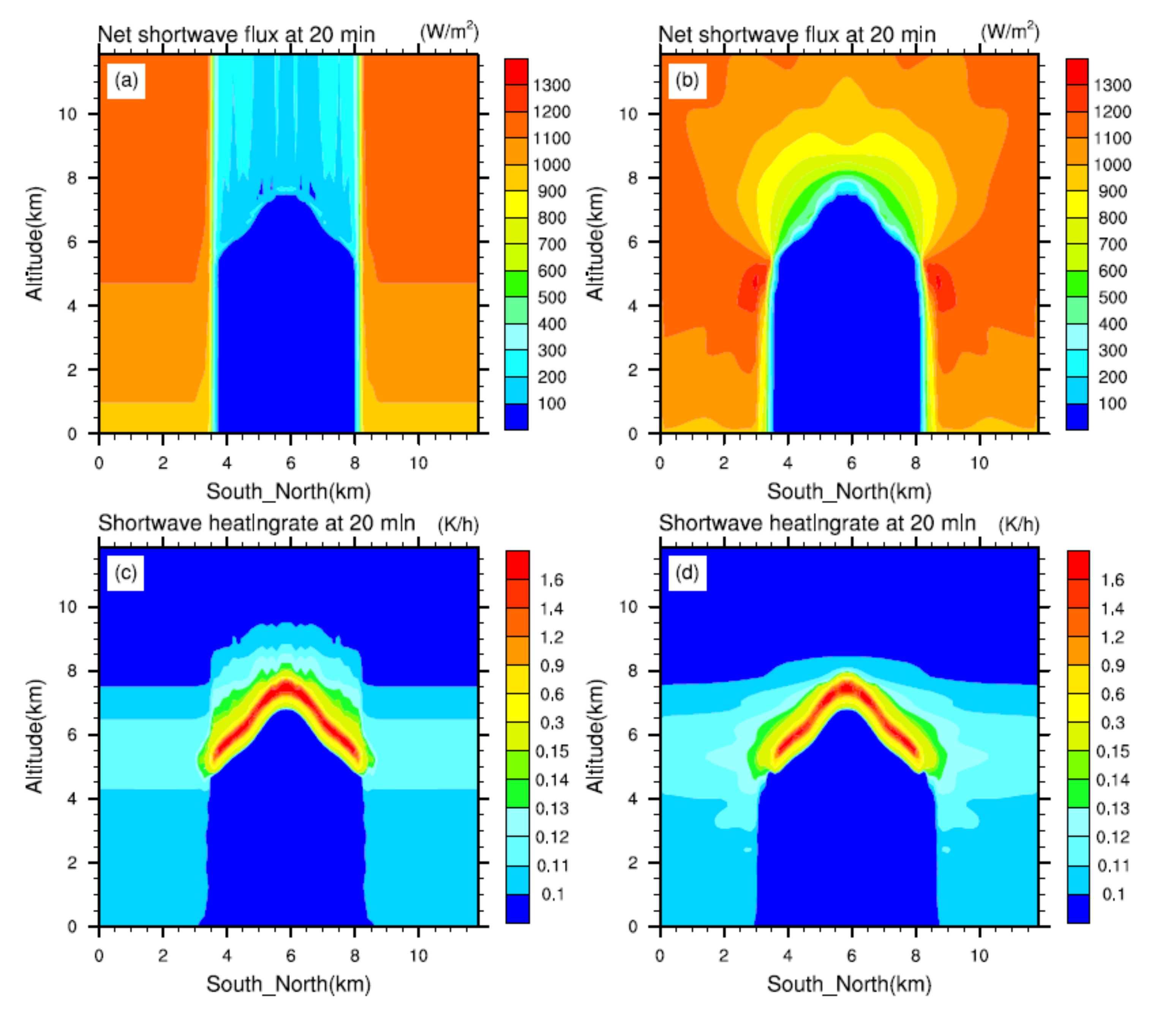
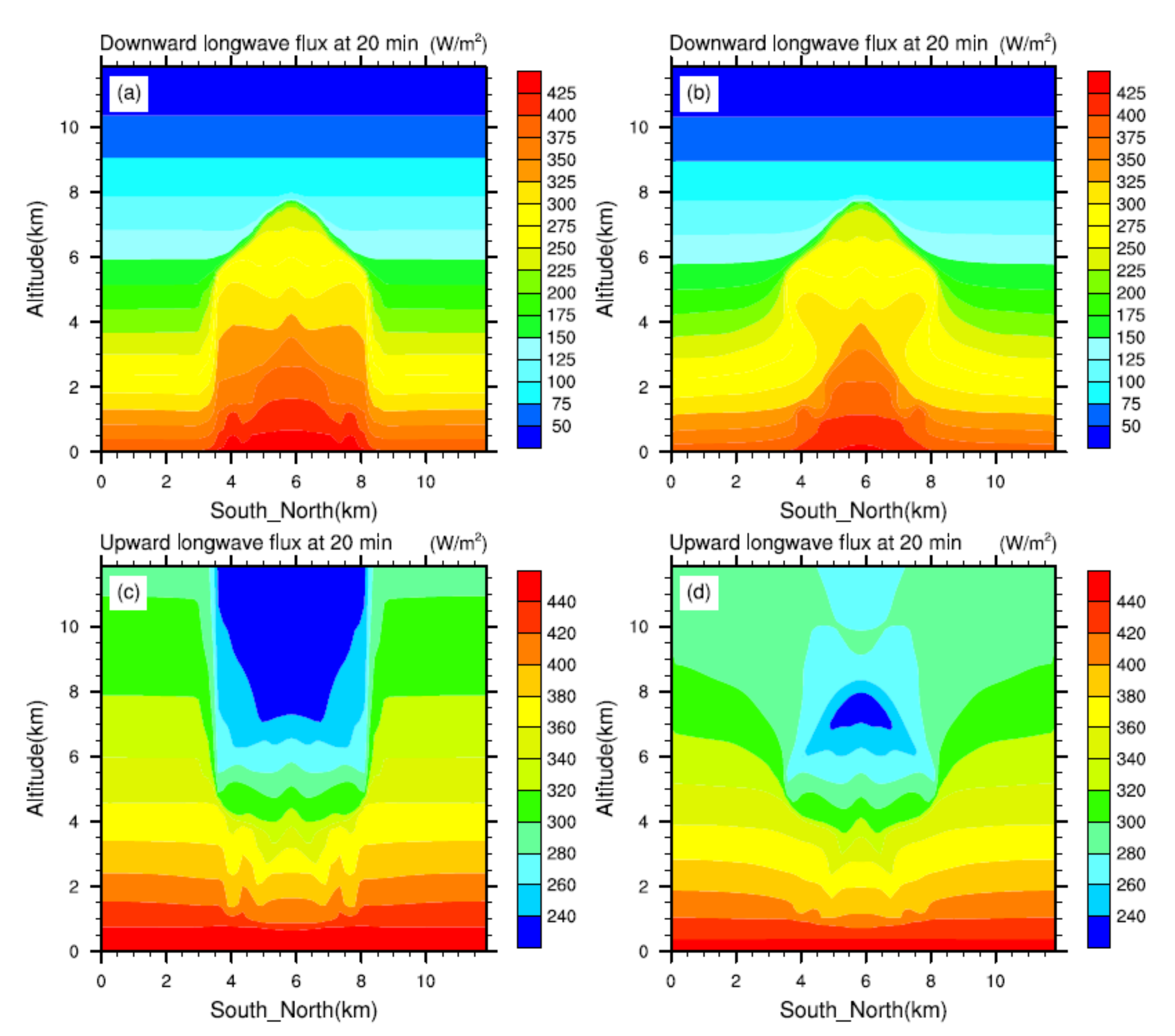
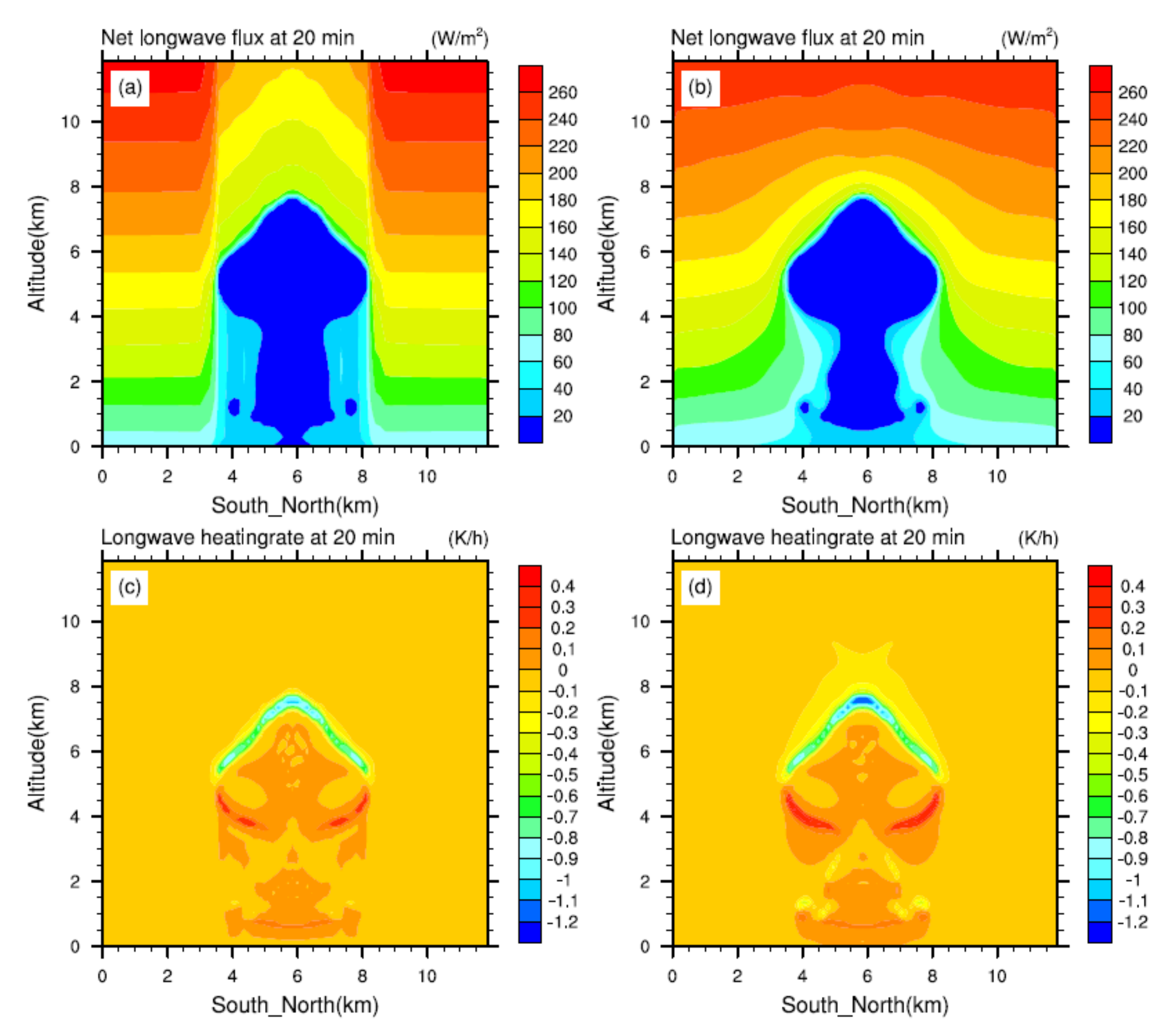
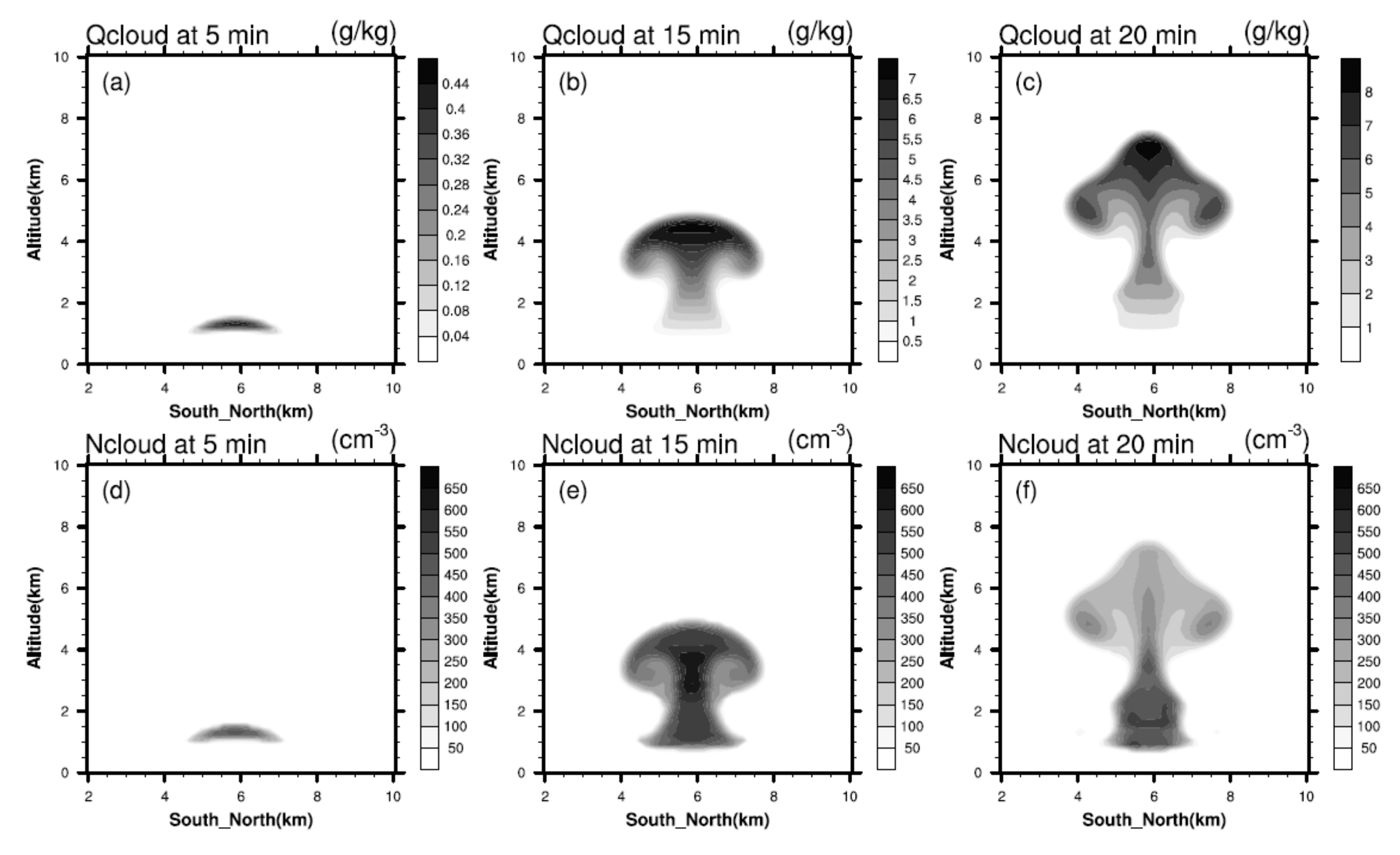
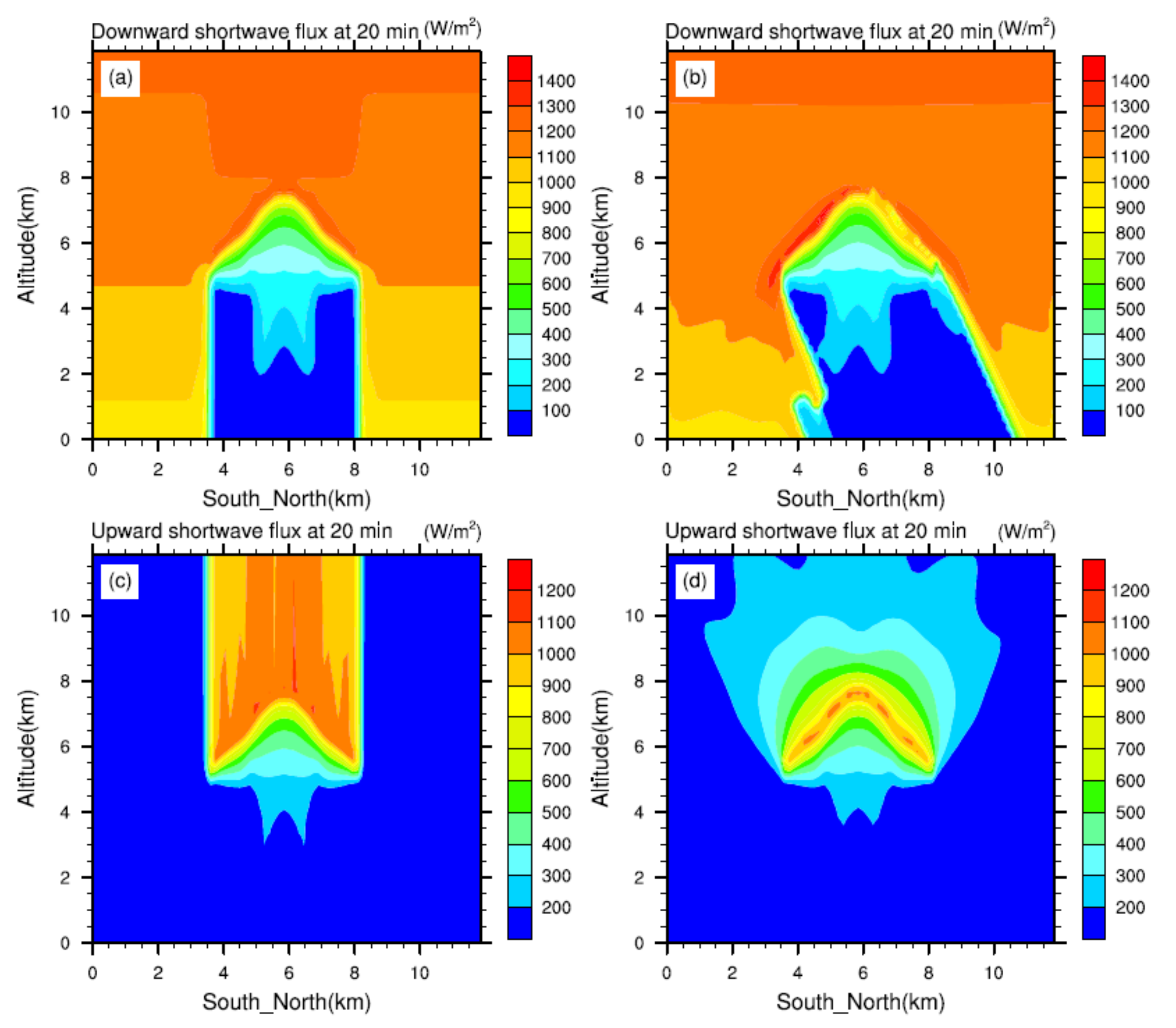
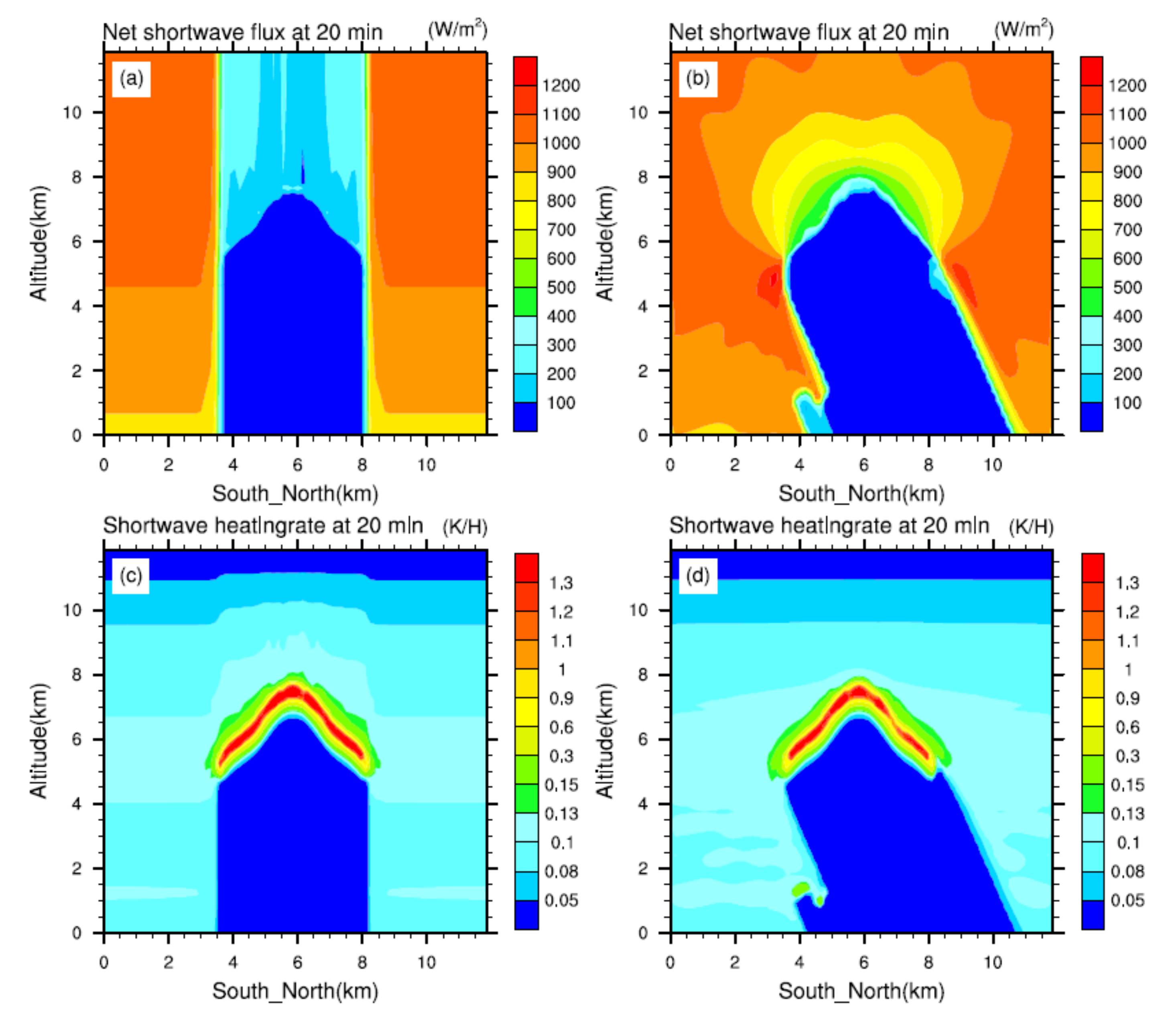
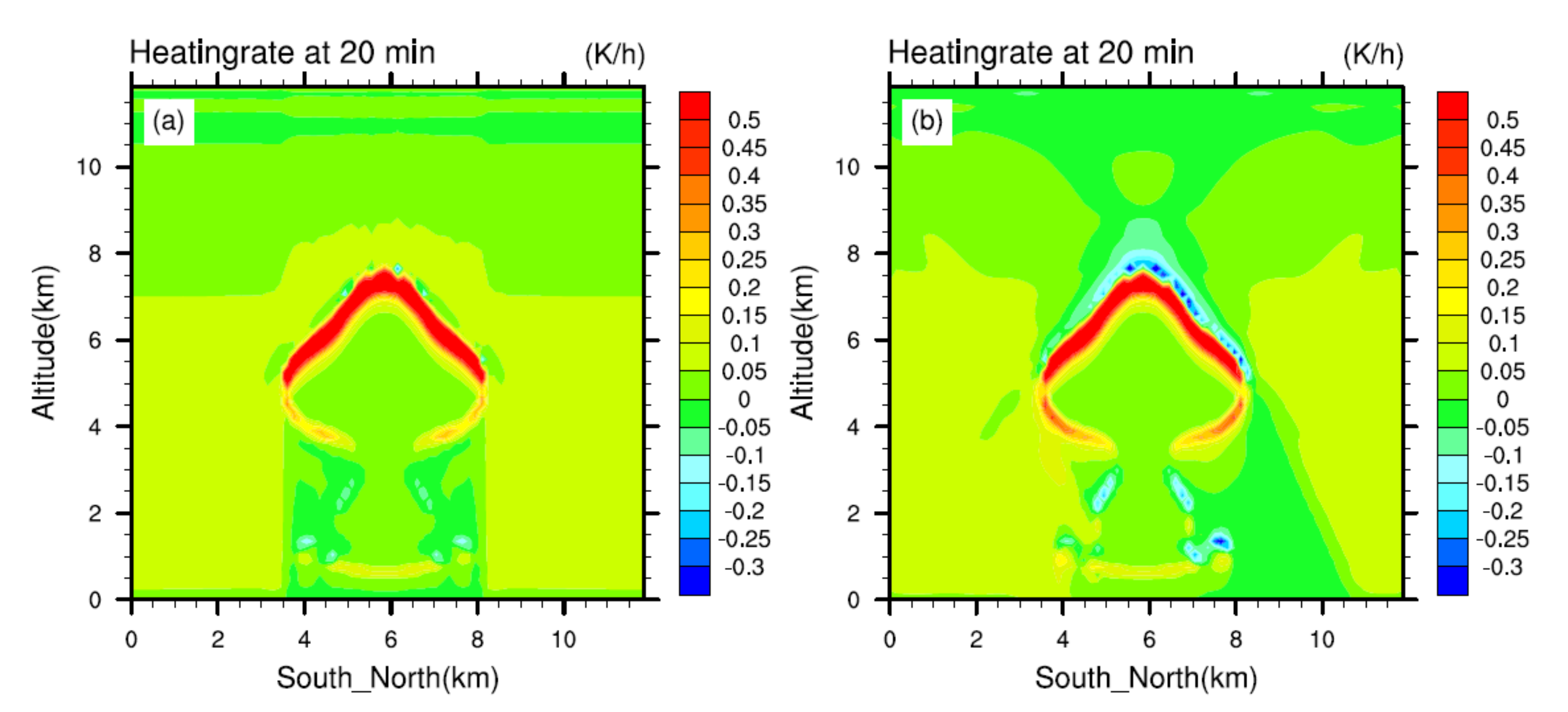
| 1 | 2 | 3 | 4 | 5 | 6 | 7 | 8 | 9 | |
|---|---|---|---|---|---|---|---|---|---|
| Shortwave | 0.2 | 0.263 | 0.344 | 0.44 | 0.625 | 0.78 | 1.24 | 1.30 | 1.63 |
| Longwave | 10 | 250 | 500 | 630 | 700 | 820 | 980 | 1080 | 1180 |
| 10 | 11 | 12 | 13 | 14 | 15 | 16 | 17 | ||
| Shortwave | 1.94 | 2.15 | 2.50 | 3.077 | 3.846 | 12.195 | |||
| Longwave | 1390 | 1480 | 1800 | 2080 | 2250 | 2380 | 2600 | 3000 |
Publisher’s Note: MDPI stays neutral with regard to jurisdictional claims in published maps and institutional affiliations. |
© 2020 by the authors. Licensee MDPI, Basel, Switzerland. This article is an open access article distributed under the terms and conditions of the Creative Commons Attribution (CC BY) license (http://creativecommons.org/licenses/by/4.0/).
Share and Cite
Zhang, T.; Sun, J.; Yang, Y. A Numerical Study of Effects of Radiation on Deep Convective Warm Based Cumulus Cloud Development with a 3-D Radiative Transfer Model. Atmosphere 2020, 11, 1187. https://doi.org/10.3390/atmos11111187
Zhang T, Sun J, Yang Y. A Numerical Study of Effects of Radiation on Deep Convective Warm Based Cumulus Cloud Development with a 3-D Radiative Transfer Model. Atmosphere. 2020; 11(11):1187. https://doi.org/10.3390/atmos11111187
Chicago/Turabian StyleZhang, Tianyu, Jiming Sun, and Yi Yang. 2020. "A Numerical Study of Effects of Radiation on Deep Convective Warm Based Cumulus Cloud Development with a 3-D Radiative Transfer Model" Atmosphere 11, no. 11: 1187. https://doi.org/10.3390/atmos11111187




